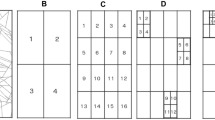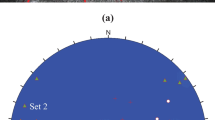Abstract
The rock fracture data provided by Swedish Nuclear Fuel and Waste Management Company were used to develop a 3-D stochastic fracture network model for a 30 m cube of Äspö diorite located at a depth of 485 m at Äspö Hard Rock Laboratory, Sweden. This fracture network model was validated. A new procedure is developed to estimate rock block strength and deformability in three-dimensions allowing for the anisotropy and incorporating the inherently statistical fracture geometry for the selected cube. The mean rock mass strength was found to be 47% of the mean intact rock strength of 297 MPa at 485 m depth. The mean rock mass modulus was found to be 51% of the intact rock Young's modulus of 73 GPa. The rock mass Poisson's ratio was found to be 21% higher than the intact rock Poisson's ratio of 0.28. These percentages indicate the level of weakening of the rock mass due to the presence of fractures. The ratio of mean major principal rock mass strength/mean minor principal rock mass strength turned out to be 1.28. The ratio of mean major principal rock mass modulus/mean minor principal rock mass modulus turned out to be 1.21.
Similar content being viewed by others
References
Cundall, P.A. (1988) Formulation of a three-dimensional distinct element model-Part 1. A scheme to detect and represent contacts in a system composed of many polyhedral blocks, International Journal of Rock Mech. Min. Sci., 25(3), 107–116.
Hermanson, J., Stigsson, M., Wei and Lingli (1998) A discrete fracture network model of the Äspö Zedex Tunnel section, A Technical Report submitted to Swedish Nuclear Fuel and Waste Management Co.
ITASCA Consulting Group Inc. (1999) 3DEC Version 2 Users Guide.
Klasson, H. and Leijon, B. (1989) Hydrofracturing stress measurements in borehole KAS02, Äspö, A Part of SKB Progress Report 25-89-17.
Kulatilake, P.H.S.W. (1985) Fitting Fisher distributions to discontinuity orientation data, J. of Geological Education, 33, 266–269.
Kulatilake,P.H.S.W. (1988) State-of-the-Art in Joint Geometry Modeling, Proceedings of the 29th U.S. Symposium on Rock Mechanics, Minneapolis, Minnesota, 215-229.
Kulatilake, P.H.S.W. (1998) Software manual for FRACNTWK-a computer package to model discontinuity geometry in rock masses, Technical report submitted to Metropolitan Water District of Southern California.
Kulatilake, P.H.S.W., Chen, J., Teng, J., Shufang, X. and Pan G. (1996) Discontinuity geometry characterization for the rock mass around a tunnel close to the permanent shiplock area of the Three Gorges dam site in China, Int. J. Rock Mech and Min Sci., 33, 255–277.
Kulatilake, P.H.S.W., Fiedler, R. and Panda B.B. (1997) Box fractal dimension as a measure of statistical homogeneity of jointed rock masses, Int. J. of Engineering Geology, 48(3-4), 217–230.
Kulatilake, P.H.S.W., Park, J. and Um, J. (2002b) Estimation of rock mass strength and deformability in three-dimensions for four 30m cubes located at a depth region of 380-500m at Äspö HRL, International Progress Report IPR-02-11, Swedish Nuclear Fuel and Waste Management Co.
Kulatilake, P.H.S.W., Ucpirti, H., Wang, S., Radberg, G. and Stephansson, O. (1992). Use of the distinct element method to perform stress analysis in rock with non-persistent joints and to study the effect of joint geometry parameters on the strength and deformability of rock masses, Rock Mechanics and Rock Engineering, 25, 253–274.
Kulatilake, P.H.S.W. and Um, J. (2002) Fracture network models in three dimensions for four 30m cubes located at a depth region of 400-500m at Äspö Hard Rock Laboratory, International Progress Report IPR-02-12, Swedish Nuclear Fuel and Waste Management Co.
Kulatilake, P.H.S.W., Um, J. and Morin B. (2002a) A case study on open pit mine rock slope stability, Proceedings of the Int. Coastal Geotechnical Engineering Conf., Atyrau, Kazakhstan, 53-62, Invited keynote Paper.
Kulatilake, P.H.S.W., Wang, S. and Stephansson, O. (1993b) Effect of finite size joints on the deformability of jointed rock in three dimensions, Int. J. Rock Mech. Min. Sci. & Geomech. Abstr., 30, 479–501.
Kulatilake, P.H.S.W., Wathugala, D.N., Poulton, M. and Stephansson, O. (1990a) Analysis of structural homogeneity of rock masses, Int. J. Engineering Geology, 29, 195–211.
Kulatilake, P.H.S.W., Wathugala, D.N. and Stephansson, O. (1993a) Joint network modeling including a validation to an area in Stripa Mine, Sweden, Int. J. of Rock Mech. & Mining Science, 30, 503–526.
Kulatilake, P.H.S.W. and Wu, T.H. (1984a) Estimation of mean trace length of discontinuities, Rock Mechanics and Rock Engineering, 17, 215–232.
Kulatilake, P.H.S.W. and Wu, T.H. (1984b) Sampling bias on orientation of discontinuities, Rock Mechanics and Rock Engineering, 17, 243–254.
Kulatilake, P.H.S.W. and Wu, T.H. (1984c) The density of discontinuity traces in sampling windows, Int. J. of Rock Mechanics and Mining Sciences, 21, 345–347.
Kulatilake, P.H.S.W. and Wu, T.H. (1986) Relation between discontinuity size and trace length, Proc. of the 27th U.S. Symp. on Rock Mech., 130-133.
Kulatilake, P.H.S.W., Wu, T.H. and Wathugala, D.N. (1990b) Probabilistic modeling of joint orientation, Int. J. for Numerical and Analytical Methods in Geomechanics, 14, 325–350.
Lanaro, F. (2001) Determination of the normal and shear stiffness of rock joints: geometry, normal and shear stiffness, A report submitted to SKB.
Mahtab, M.A and Yegulalp, T.M. (1984) A similarity test for grouping orientation data in rock mechanics, Proc. of the 25th U.S. Symp. On Rock Mech., 495-502.
Nisca, D.H. (1988) Geophysical laboratory measurements on core samples from KLX01, Laxemar and KAS02, Äspö, SKB Progress Report 25-88-06.
Nordlund, E., Li, Chunlin and Carlsson, B. (1999) Mechanical properties of the diorite in the prototype repository at Äspö HRL, SKB International Progress Report 99-25.
Shanley R.J. and Mahtab, M.A. (1976) Delineation and analysis of clusters in orientation data, Mathematical Geology, 8, 9–23.
Terzaghi, R. (1965) Sources of error in joint surveys, Geotechnique, 15, 287–304.
Wang, M., Kulatilake, P.H.S.W., Um, J. and Narvaiz, J. (2002) Estimation of REV size and three-dimensional hydraulic conductivity tensor for a fractured rock mass through a single well packer test and discrete fracture fluid flow modeling, Int. J. Rock Mech. Min. Sci. & Geomech. Abstr., 39, 887–904.
Wathugala, D.N., Kulatilake, P.H.S.W., Wathugala, G.W. and Stephansson, O.A. (1990) A general procedure to correct sampling bias on joint orientation using a vector approach, Computers and Geotechnics, 10, 1–31.
Author information
Authors and Affiliations
Rights and permissions
About this article
Cite this article
Kulatilake, P.H.S.W., Park, J. & Um, Jg. Estimation of rock mass strength and deformability in 3-D for a 30 m cube at a depth of 485 m at Äspö Hard Rock Laboratory. Geotechnical and Geological Engineering 22, 313–330 (2004). https://doi.org/10.1023/B:GEGE.0000025033.21994.c0
Issue Date:
DOI: https://doi.org/10.1023/B:GEGE.0000025033.21994.c0




